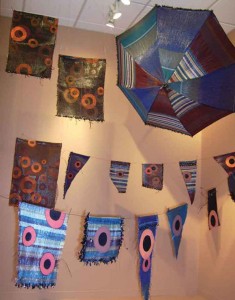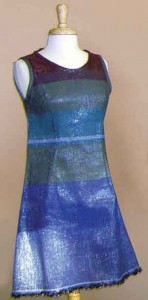The August heat rises off the asphalt as we hurry across the wide streets, heading towards the San Jose Museum of Quilts and Textiles. Part of the 2006 International Symposium on Electronic Arts, the ZeroOne festival is filled with a myriad of mobile, locative and interactive media artworks including Alyce Santoro’s Sonic Fabric creations.
The entrance to the textile museum plays host to Santoro’s woven audiotape fabrics, suspended in rows similar to the Tibetan prayer flags that influence this work. Alongside are everyday items of clothing: a dress, a poncho and an umbrella, all constructed from interwoven cotton and recycled audiotape. The tape recordings are given a second life in these garments. Like the blessings inscribed on Tibetan prayer flags and excited by the wind, the sound-collage of woven tape is brought alive when “played back” by a modified walkman (where the playback head has been shifted to the outside of the device). Emanating from the material are not (as might be expected) the partially recognisable song samples from a pre-loved cassette, but an audible texture of noise.
Santoro’s Sonic Fabrics and the clothes constructed from them are positioned in the realm of conceptual art practice rather than in the field of what is emerging as the ‘traditional’ form of wearable technology, where the outcome of interaction is discernible. To the uninformed observer these pieces could be seen purely as trendy garments, yet to the wearer each is unique, containing many secrets within. They are the sounds of interlaced memories; a recorded history recreated into the tangible wearable object.
With a background in both science and art, Santoro felt she did not fit into either conventional role. Yet a beautiful marriage arises when this knowledge and skill-set is combined within her Sonic Fabrics. Informing her work is Santoro’s experience in scientific illustration. Colours of the ocean and its inhabitants are adopted into intricately crafted “street wearable” clothing. The fabric is tightly woven producing a lustrous flat surface, which easily lends itself to fashion design. Using simple patterns, her works reflect clothing preferences of a stylish and technologically-compassionate city-dwelling generation.
The problem with this exhibition is not the work itself, more so, the stasis of the display. These fabrics are constructed to flutter in the wind and to reflect the sunlight of the strips of audiotape as someone perhaps strides past in a crowd. These pieces could be alive on the street and are not suited to the gallery environment. Wearables (as the name suggests) long to be worn. It is only then that their inherent properties manifest. A second issue arises, related to listening to the fabric’s content. The modified walkman used in accessing the audio is a clunky device. Are the sonic fragments intended only as a conceptual component? If so, is it necessary to ever listen to them? Perhaps some histories are never meant to be heard, only imagined.
Inside the Museum shop, three Sonic Fabric bags – in purple, green and blue – are for sale. After endless “trying on”, the prospective buyer is perplexed. Ultimately, fashion prevails. Colour coordination with the buyer’s existing wardrobe becomes the predominant factor, and we leave empty handed.
Somaya Langley
Somaya Langley interviews eminent artists, writers, curators and researchers in the fields of media arts, experimental sound and emerging technologies to bring you insightful and intimate glimpses into their creative processes.
Watch More
 This work is licensed under a Creative Commons Attribution-NonCommercial-ShareAlike 2.5 Australia.
This work is licensed under a Creative Commons Attribution-NonCommercial-ShareAlike 2.5 Australia.








